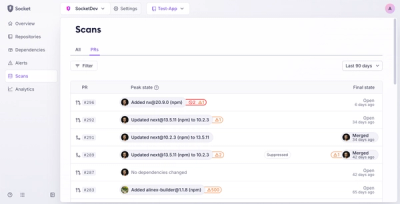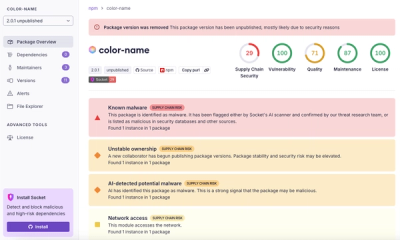
Security News
MCP Steering Committee Launches Official MCP Registry in Preview
The MCP Steering Committee has launched the official MCP Registry in preview, a central hub for discovering and publishing MCP servers.
active-mdx
Advanced tools
Content Modeling for MDX
MDX is a great enhancement for Markdown. Where regular Markdown renders to static html, MDX provides you with a dynamic, react based output which you can customize and make interactive, whether by embedding React components, or customizing the components used to render the markdown output.
ActiveMDX works in Node.js and provides a structured content modeling API on top of Collections of MDX files in a folder and its subfolders. This lets you work with the collection of documents as if it was a database, an individual document being a record, and the structure of the content ( and YAML frontmatter ) determining its attributes. When you combine the custom presentation of MDX and React, with data derived from the content itself, it opens up powerful possibilities.
Active MDX is a Content Modeling library which lets you develop Models for the different types of MDX documents in your project. A Model assumes that a document follows a known heading and sub-heading structure. For example, A Recipe will have an ## Ingredients section and a ## Steps section. Active MDX Models allow you to turn any MDX Document into a JSON object by providing helpers for working with the document in AST form. What goes into the JSON object will depend entirely on what you are writing inside of this predicable structure. Active MDX Models are backed by a Document class which provides you with many utilities for turning the content being written about into structured data.
The data Active MDX makes available based on what is being written about can be used to power all sorts of applications. If you are building a website which which is a cookbook that has a dozen recipes, Active MDX can give you a database of all of the ingredients and quantities and you could render a button to place the order let users find a recipe based on what ingredients they had.
$ npm install active-mdx
ActiveMDX works on the server, in Node.js. Use later versions of node which support esm modules natively.
To start with, you have a folder that contains mdx files.
├── epics
│ ├── authentication.mdx
│ └── search.mdx
├── index.js
├── index.mdx
├── models
│ ├── Epic.js
│ └── Story.js
└── stories
├── authentication
│ └── a-user-should-be-able-to-register.mdx
└── search
└── searching-for-a-product-by-category.mdx
This folder is represented by an instance of the Active MDX Collection
// index.js
import { Collection } from "active-mdx"
// load({ models: true }) will automatically register ./models/*.js as model classes
export default new Collection({ rootPath: "./content" })
You can use this anywhere
import collection from './index.js'
collection.load({ models: true }).then(async (collection) => {
const Epic = collection.model('Epic')
const epics = Epic.query(qb => qb.where("status", "completed")).fetchAll()
})
The mdx files inside of the epics folder are represented by a Model that we defined in ./models/Epic.js. A Model defines how this document relates to other documents in the project, and how information from the content of the document can be represented as data.
// ./models/Epic.js
import { Model } from "active-mdx"
import Story from "./Story.js"
export default class Epic extends Model {
stories() {
return this.hasMany(Story, {
heading: "stories",
meta: () => ({ epic: this.title.toLowerCase() })
})
}
get isComplete() {
return this.stories().fetchAll().every((story) => story.meta.status === 'completed')
}
static is(document) {
return document.id.startsWith("epic")
}
}
This will take mdx content such as epics/authentication.mdx
---
status: proposed
---
# Authentication
The Authentication stories cover users logging in and out of the application, as well as the roles and permissions granted to these users and how they are enforced in the application.
## Stories
### A User should be able to register
As a User I would like to register so that I can use the application.
### A User should be able to login
As a User I would like to login so that I can use the application.
In addition to displaying the Epic in MDX form, we can also work with it as data and reference the things contained in the writing itself.
const authEpic = collection.getModel("epics/authentication")
console.log(authEpic.toJSON({ related: ["stories"], attributes: ["isComplete"] }))
/*
{
"id": "epics/authentication",
"meta": {
"status": "proposed"
},
"title": "Authentication",
"stories": [
{
"id": "stories/authentication/a-user-should-be-able-to-register",
"meta": {
"epic": "authentication"
},
"title": "A User Should be able to Register"
},
{
"id": "stories/authentication/a-user-should-be-able-to-login",
"meta": {
"epic": "authentication"
},
"title": "A User should be able to login"
}, ...
],
"isComplete": false
}
*/
Every model has access to an underlying Document class, which provides methods for Querying the AST and Shortcuts to AST Nodes which can be used to extract data from the writing content.
The Document class API also provides methods for manipulating the content of the documents programatically such as
replaceSectionContent("Section Title", "- new\n - markdown\n - list\n")appendToSection("Section Title", "[Link](www.google.com)")For a full list of what is available in the API See The API Documentation
The package ships with a bin amdx which can be used to initialize a new project, and work with the documents and models.
$ amdx --help
FAQs
models for markdown documents
We found that active-mdx demonstrated a not healthy version release cadence and project activity because the last version was released a year ago. It has 1 open source maintainer collaborating on the project.
Did you know?

Socket for GitHub automatically highlights issues in each pull request and monitors the health of all your open source dependencies. Discover the contents of your packages and block harmful activity before you install or update your dependencies.

Security News
The MCP Steering Committee has launched the official MCP Registry in preview, a central hub for discovering and publishing MCP servers.

Product
Socket’s new Pull Request Stories give security teams clear visibility into dependency risks and outcomes across scanned pull requests.

Research
/Security News
npm author Qix’s account was compromised, with malicious versions of popular packages like chalk-template, color-convert, and strip-ansi published.